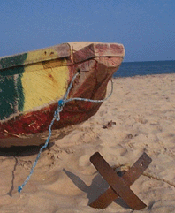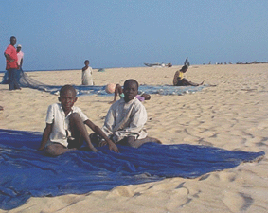
a typical fishing boat

fisherfolks at work
The main economic activities
Farming
In the south, some of the main crops are sugar cane and vegetables such as ahallots, okro and tomatoes. Coconut is also cultivated along the coastline. In the central part of the Volta Region, all kinds of foodstuffs are cultivated. These are maize, cassava, yam, groundnut, beans and cocoyam. Others are oil palm, cocoa, coffee, sugar cane, rice and a wide range of fruits; namely, oranges, pears, pineapples, etc. In the north the main crops are yam, cassava, maize, millet, beans and groundnuts.
Fishing
Along the coast, fishing is very popular. Main catches from the sea include sardines, anchovies, herrings, horse-mackerel, barracuda and lobster; while from the lagoon come tilapia, mudfish, crabs and shrimps. The Volta Lake that occupies the central and northern parts is very rich in a variety of fresh water fishes such as tilapia, clarias, mudfish and catfish.
|
a typical fishing boat |
fisherfolks at work |
Animal Rearing
Cattle, sheep and goats are reared all over the Savannah areas running from the south to the north. This region has far more cattle than most regions of Ghana. Poultry is kept in most rural area.
Petty Commerce
This ranges from "tabletop shops" to hawking of several articles of trade. Almost every house has something to sell.

Kente material
Tourism
It is estimated that about 5 % of all tourists visiting Ghana visit the Volta Region. It is important to state that several tourists us Aflao Border as a transit point large proportion of tourists visiting the Volta Region are mostly from Germany, Denmark, Holland, UK and USA. Most of them are of the average age of twenty four years. They are mostly adventurists. These young tourists prefer cheaper and smaller hotels and to eat in "chop bars". The general impression the tourists have about the region is that it is extremely beautiful, the people hospitable and warm.
|
Keta Beachhead's gun |
young beachers |
Lagoons, beaches, the Volta River